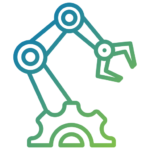URLLC applications envisioned in 5G [Panwar et al., 2016] include remote surgery, industrial and robotic automation, often also encompassed within the “Tactile Internet” concept [Fettweis, 2014], all of which require extremely low loss, latency, and delay variations. Such ULL machine-to-machine communications require not only “maximum” but “deterministic” latency, jitter and throughput. Packets should not only not exceed a certain target latency, but should also not be delivered any sooner since some industrial controllers require very precise synchronization and spacing of telemetry streams and control data, for example, to facilitate the precise and in-sync operation of robotic actuators.
To achieve low-latency by reducing the propagation latency and the processing latency introduced by each networking device, Industry 4.0 applications need to be placed close to the control targets. Since on customer premises (e.g., inside the factory) data centers are often not an alternative (e.g. requiring a virtual private 5G network and adequate compute infrastructure), fog computing infrastructures and MEC servers are considered candidate choices to host real-time cloud cooperative applications. However, the layers of software virtualization and limited QoS functions throughout the network path compromise the delivery of deterministic latency capabilities.
This research strand will explore Industry 4.0 control scenarios where the control logic and telemetry processing functions of the targets (e.g. robots, drones, IoT devices) are offloaded to programmable hardware network devices placed at the edge (first network hops). In-network P4 programmable edge hardware approaches [Cesen et al., 2020] can be exploited to provide (partial) TSN support to guarantee that critical packet processing and control operations can be done at line rate with low and deterministic latency due to the physical proximity of the edge P4 equipment and the bounded timing guarantees due to hardware-based pipeline implementations [Michel et al., 2021]. We foresee that those methods could be also applied to mobile robots or unmanned flying vehicles, which also benefit from in-network acceleration of (edge) cloud-based applications in support of coordinated, timely operations. The exploration of a cloud-network digital twin approach will contribute to broader and more effective testing as well as safer network configuration changes [Zhao et al., 2022].







